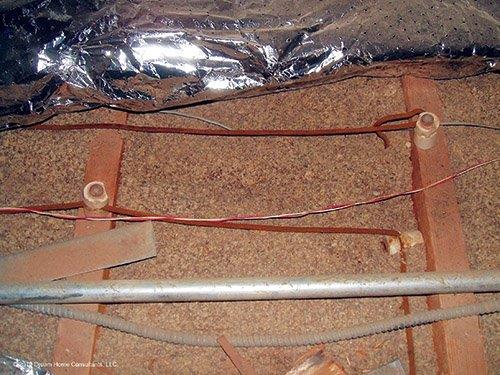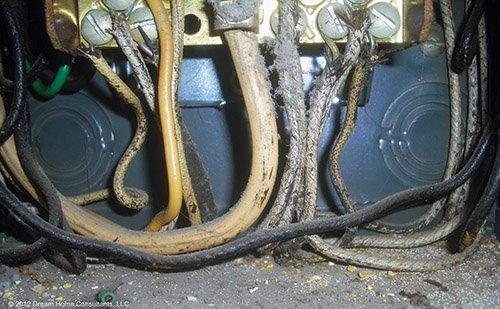What’s a Wiring Method?
A wiring method is a system that conducts electricity from the connection at the home’s wiring (the service point) to where it is used (an outlet). The most common example of a wiring method is nonmetallic sheathed cable (NM), often referred to by the trademark name Romex.® The Romex trademark is owned by Southwire, and only Romex brand NM should be called Romex.
Knob and tube is a wiring method. So is BX® (another brand name). Service entrance cable (SE) is a wiring method that is commonly used between the service point and the main electricity cutoff devices (the service equipment). The various types of conduit and tubing are different wiring methods, each with different installation requirements.
The Wayback Machine (WABAC) – Knob and Tube
Let’s step into the WABAC machine to find out about one of the earliest commonly used wiring methods that’s still in use: knob and tube. Younger inspectors: Google “Peabody’s Improbable History” to understand the WABAC reference. It’s a classic cartoon.
Our trip in the WABAC machine would probably take us any time from the early 1900s to the 1930s. We could, however, find ourselves in a home built as late as the early 1970s (but that’s pretty unlikely). In fact, knob and tube wiring may be installed today as an extension of existing knob and tube wiring or by permission from the local building department.
One characteristic of homes built when knob and tube was popular was a lack of (or minimal) thermal insulation. Covering knob and tube with thermal insulation is a bad idea but not necessarily for the reason many of us believe. Under normal operating conditions, knob and tube covered by thermal insulation should not overheat more than any other wiring method. Thermal insulation-covered knob and tube may be damaged by attic traffic, and carelessly installed thermal insulation may push the wires too close to framing and other surfaces. These are good reasons for not covering knob and tube with thermal insulation. The NEC (Article 394.12) does not allow covering knob and tube with thermal insulation in hollow spaces of walls, ceilings and attics, so thermal insulation-covered knob and tube is a reportable deficiency in most areas. Some jurisdictions, however, allow thermal insulation-covered knob and tube. Contact between knob and tube and metal, such as pipes, ducts, foil vapor retarders and foil radiant barriers is a job for Obviousman (No Duh). This is a major reportable deficiency. See Picture 1.
 Knob and Tube Done Right
Knob and Tube Done Right
Properly installed knob and tube should have these characteristics:
1. At least 1 inch distance between the wires and objects like walls, floors and framing.
2. At least 3 inches distance between the wires.
3. Not more than 6 inches between knobs and a wire splice, including splices in boxes.
4. Not more than 4 ½ feet between knobs in wire runs.
5. Wires run on the sides of joists, rafters and studs, not on top.
6. Tubes installed where the wires penetrate framing.
7. Taps between knob and tube wires and other knob and tube wires may occur outside of covered junction boxes. The taps should be soldered and taped.
8. Taps between knob and tube wires and other wiring methods should occur inside a covered junction box or conduit body.
9. Wiring methods should enter boxes with appropriate protection and should be secured near the box as required. Each knob and tube wire should enter the box through a separate opening protected by a bushing. NM cable should enter the box through a clamped opening and should be secured within 12 inches from the box.
Knob and Tube Problems
There’s nothing wrong with knob and tube wiring if it’s installed correctly; if the circuit isn’t overloaded; and if the insulation, knobs and tubes are intact and safe. That’s a whole lot of ifs—too many for some homeowner insurance companies. You perform a great service to your client by advising them to contact their homeowner insurance company immediately to determine the company’s underwriting standards for homes with active knob and tube wiring. The company may require potentially costly rewiring before issuing a policy.
Let’s face it, knob and tube wiring is at the end of its service life, a reportable condition by itself according to our standard of practice. It usually has no equipment grounding conductor, which is a safety issue. It’s a 15-amp circuit and may have more lights and receptacles connected to it than is safe. It’s a potential asbestos containing material (insulation). Bottom line: It’s wise to report the presence of knob and tube wiring (active and inactive) and recommend evaluation of active knob and tube by an electrician with a lot of gray hair or at least some experience with knob and tube.
WABAC – Greenfield
Our trip in the WABAC machine might take us to the early 1900s or later to see a wiring method called Greenfield, named after one of its inventors. Greenfield flexible conduit is the ancestor of what’s now called Flexible Metal Conduit (FMC). In fact, FMC is sometimes called Greenfield, especially by the gray-haired electricians. You may not see much Greenfield because its cousin, BX, became more popular for residential wiring.
FMC looks a lot like armored cable (see next paragraph) and shares most of the same installation requirements as armored cable and NM. A significant difference is that FMC is listed for damp locations. If you need a wiring method for a damp location, you’re probably better off with Liquid-tight Flexible Conduit (LFC) because it’s allowed in more situations.
 WABAC – BX (Armored Cable)
WABAC – BX (Armored Cable)
Another trip in the WABAC machine could take us any time from the early 1900s to yesterday to find BX cable. BX started becoming popular in the 1930s, about the same time as knob and tube started to wane. BX is a trademark owned by General Electric (just as Romex is owned by Southwire). The correct name for this wiring method is armored cable (AC). See Picture 2.
The armor on AC looks a whole lot more formidable than the PVC jacket on NM. Funny thing is, the installation requirements for AC and NM are almost the same. Neither should be installed in wet or damp areas, including inside buried conduit and conduit installed outside. Both may be run exposed, but neither should be installed where subject to physical damage. What does subject to physical damage mean? There is no agreed-upon definition of the term. It’s like Justice Potter Stewart said about pornography: “I know it when I see it.”
A frequent question is whether AC’s armor may be used as a grounding conductor. For AC after 1959, the answer is definitely yes. Manufacturers added a bonding strip to improve the armor’s conductivity starting in the mid-1950s, and this was required beginning in 1959. For earlier AC, the answer is a qualified yes. The earlier AC was designed to have the armor act as a grounding conductor, but age and corrosion may increase the armor’s resistance past the point of effectiveness. Another problem with older AC is unraveling of the armor that, in some cases, can impede the flow of electricity in the conductors causing significant heat.
 WABAC – Rag Wire
WABAC – Rag Wire
Yet another trip in the WABAC machine could take us back as early as the late 1920s, but is more likely to land us in the 1940s or 50s, to find this early form of NM cable. See Picture 3. It gets its somewhat derogatory nickname from its cotton or rayon sheathing. The 1960s saw the cloth sheathing give way to the plastic sheathing we know and love today.
The main problems with rag wire are that the cloth sheathing and the wire insulation deteriorates and becomes brittle with age. The other problem, shared by most old wiring methods, is lack of a grounding conductor.
 Grounding that Ungrounded Receptacle
Grounding that Ungrounded Receptacle
So how do you answer the question about what to do with ungrounded receptacles when there’s no equipment grounding wire? The best thing to do is run a new cable with a grounding wire, but nobody wants to hear that. You could run a grounding wire back to the circuit’s point of origin or to an accessible point at the grounding electrode or grounding electrode conductor, but if you’re going to all that trouble, you might as well run a new cable. One easy fix is to replace the old two-slot receptacle with a GFCI receptacle. Be sure to label the receptacle “No Equipment Ground.” Another easy fix, assuming the box is grounded, is to simply install a jumper to the grounded box.
Here’s what you shouldn’t do. Don’t run a grounding wire to a separate ground rod. Don’t run a grounding wire to a metal water or gas pipe. Grounding to a metal water pipe was allowed at one time, but because dielectric unions and plastic pipes can break the pipe’s electrical continuity, this is no longer allowed. Grounding to a gas pipe is never allowed. Don’t install a jumper between the receptacle’s grounding and neutral terminals (sometimes called a bootleg ground). See Picture 4. All of these create a potentially dangerous alternate return path for electricity if something goes wrong. Don’t replace the two-slot receptacle with an ungrounded three-slot receptacle. This provides the dangerous illusion that everything is done correctly.
The Bottom Line
Part of buying an older home is dealing with the older components. Some old components are charming. Some, however, are potentially dangerous. Old wiring methods fall into the potentially dangerous category. The Word likes to warn clients about the potential fire and shock dangers of old wiring methods. You might consider doing this too.
(The information above was written by Bruce Barker for “The Word”, ASHI Reporter, November, 2013 issue.)
